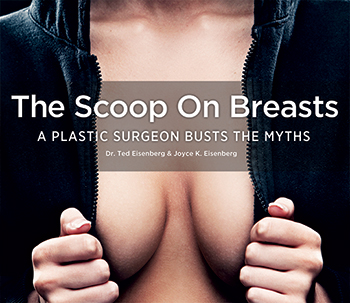Breast Reduction Philadelphia
Are you unhappy with the size of your breasts? A breast reduction, or reduction mammaplasty, not only reduces the size of your breasts to make them in proportion to your body but also lifts and reshapes them.
Women consistently report that they feel an enormous amount of relief from their neck, back or shoulder pain sometimes as early as the morning after their breast reduction surgery.
At your free consultation, Philadelphia plastic surgeon Dr. Ted Eisenberg will answer all of your questions about breast reduction surgery. Read recent patient reviews here.

“My figure is finally in proportion.” – Ashley S.
If you have stopped growing, which means that there have been no changes in your height, weight and breast size for two years, you would be a candidate for breast reduction surgery (reduction mammaplasty). On average, most women are finished growing by age 18.
The goal of the surgery is to reduce your breasts to a size and weight that are appropriate for you and more proportional for your body. It’s not a one-size-fits-all approach. There is a limit to how much tissue can be removed because there has to be enough circulation remaining to supply the nipple and areola with blood. That’s why, if a woman is disproportionately large-breasted, Dr. Eisenberg can sometimes reduce her size only by half, which may still leave her with a fair amount of breast tissue.
You’ll see pictures of the breast lift incision, which is anchor-like in shape; it goes around the nipple, extends from the nipple down to the breast fold and then in the breast fold itself. Healing is usually very good and is helped by Dr. Eisenberg’s use of dissolvable stitches, which do not have to be removed. See our before and after gallery.
To read Dr. Eisenberg’s Breast Blog, click here.
Breast Reduction Surgery
Dr. Eisenberg performs breast reduction surgery in the safety of the operating room at Nazareth Hospital. On the day of surgery, your support person can stay with you until you are transferred to the operating room. That means he or she can be by your side when you meet the anesthesiologist and when Dr. Eisenberg marks the incision site, takes pictures for you and your records, and reviews your postoperative medications and diet.
During breast reduction surgery, Dr. Eisenberg will mark your breasts to indicate the new, higher position of the nipple and the amount of breast tissue to be removed. The markings often resemble the shape of a keyhole. During the procedure, the skin and glandular tissue are excised. The nipple, which is still attached to the breast, is moved up into place. The breast and its envelope of skin will be sewn together to restore the breast shape. In rare circumstances, when the breast is so large that circulation to the nipple cannot be maintained, the nipple is removed and grafted back on.
The procedure takes approximately three to four hours. After surgery, you will be cared for in the recovery room by skilled and compassionate nurses. You’ll be placed in your special support bra, and Dr. Eisenberg will discharge you. You must arrange for someone to drive you home.
“You showed such expertise, understanding and patience.” – Lisa D.
Recovery
You can shower the day after surgery.
Patients report minimal discomfort after breast reduction surgery. They describe a little bit of soreness underneath their breasts for a few days. Dr. Eisenberg will prescribe medications to make you more comfortable during this period. More than 90 percent of patients say they are back to work in an office setting on the fifth day.
It’s best to have someone stay with you the first night following your surgery so that you can rest. You can shower the day after surgery. If you have small children, you will need help lifting them for the first few days. By the third day, many women are able to comfortably lift their children for short periods of time and drive a car – if they are not taking narcotics.
Your first postoperative visit is usually within a week. You’ll wear your special support bra continuously for two weeks and then part-time for an additional four weeks.
Frequently Asked Questions
Will a reduction lift my breasts, too?
Yes. A breast reduction not only reduces the size of the breasts but also lifts and reshapes them. The goal of both breast reduction and breast lift surgery is to restore the breast to a more youthful appearance. The procedures are similar, except that breast reduction surgery involves removal of skin and tissue; breast lift surgery involves only skin.
I’m on a diet. Should I wait to get a breast reduction?
Yes, because if you lose 10 percent or more of your body fat, your breasts can get smaller and droopier. The best chance of having a satisfactory long-term result is to wait until you are closer to your goal weight.
Will I be able to breastfeed after a breast reduction?
When the nipple is repositioned to a higher position, some milk ducts may be cut, which means that milk production following pregnancy could be reduced. In this case, breastfeeding might still be possible, but it may be necessary to supplement with formula.
“In 1994, you reduced my breasts and my daughter’s. I’m now 62, and my breasts are still good. Since then, my daughter has had two children and was able to breastfeed. Thank you for preserving her ability to breastfeed; she was 18 at the time of her breast reduction surgery. I recommend you to any woman I see who is carrying too much up front.” – Pam




 CLICK HERE TO BUY
CLICK HERE TO BUY








